Notes from my summer travels, Part I
A month of travel, a few good hotels, and the reminder that health is simpler than we think
If you asked me to describe perfect happiness, I’d point to a morning swim in the Mediterranean: cool, clear water; blue horizon meeting blue sky. The sea holding me steady, the rare feeling of nothingness and completeness at once. That elusive state mindfulness chases but rarely delivers—being fully present, wanting nothing.
This summer, in Greece, Italy, and Spain, I was lucky enough to live inside that feeling more than once. After three or so years of not taking more than a few days off, Emi and I finally gave ourselves time to slow down: to walk through cities without an agenda, to eat well, to sit with family, and to let days expand.
Along the way, I kept getting questions about how I stay consistent with wellness while traveling, and which places I’d recommend to stay. This post is my attempt to answer: part travelogue, part routine, part reflection on what Americans might learn from Europeans.
On keeping a routine while traveling
For me, nothing sets the tone of a trip more than how I prepare for a long flight. Bringing my own food makes a world of difference in how I feel once I land. Even in business class, airplane food is often heavy, sodium-laden, and reheated in plastic. A small amount of preparation goes a long way.
If I’m leaving from home, I’ll pack simple staples: hard-boiled eggs, a small tub of hummus, raw chopped vegetables, a sandwich with protein and greens, a handful of raw nuts, a piece of fruit, a bar of good dark chocolate, and a scoop of protein powder in a shaker bottle.
When I’m not leaving from home, I’ll stop at a grocery store or health food shop before my flight. The choices vary, but I can always find something: ready-boiled eggs, yogurt, a pre-made sandwich, nuts, fruit, even decent chopped vegetables. It requires a small shift in priority and preparation but it consistently pays off.
My other non-negotiables for long-haul flights are hydration and movement. I drink at least two to three liters of water and I get up every hour to walk the aisle or stretch. I’m always amazed by how many people sit motionless for eight or ten hours. One note on water: buy your own before boarding. Airplane water tanks are notoriously under-cleaned; I avoid hot drinks on planes for this reason.
On arriving at my destination
I don’t try to do it all when it comes to routines. That’s a recipe for failure. I choose a few anchors—sleep, exercise, and eating whole foods—and let the rest go.
For sleep: I aim for eight hours, keep my room dark and cool, take magnesium at night, and, if I’ve crossed time zones, use a small dose of melatonin for the first few nights. Good sleep depends as much on the set-up as the habit. This is why I almost never stay in Airbnbs—too many misses. Hotels are nearly always more reliable. Another reset trick: natural light first thing. Huberman will tell you to get “sun in your eyes”, but I find stepping onto a balcony, sitting by an open window, or taking a short walk does the job. When traveling, more than ever, it pays not to major in the minors.
For movement: if I’m away for weeks at a time, I need a hotel with at least a basic gym—bench, dumbbells, treadmill. I’ll pack a foam roller and resistance bands, which cover everything else. When I train, I usually follow my trainer’s app, but I also like Kirsty Godso’s Pyro. Another great option: GPT. Give it a list of the equipment you have and it will generate a full-body workout with weights, sets, and reps. It never fails to deliver.
But strength training aside, I can’t imagine a day without movement. In cities, I walk everywhere. Near water, I swim. On large resort properties, I’ll walk, take stairs, and skip the buggy rides. The options are endless; the point is to find something you enjoy and do it every day.
Before moving on to food, here are a few hotels I love—places that make it easier to sleep well, move well, and feel at home:
New York: The Greenwich Hotel has become my home away from home since moving to Austin. Perfect rooms, excellent gym, thoughtful staff, and a location I love.
London: 1 Hotel Mayfair is my go-to: comfortable, clean, good gym, central. Their West Hollywood property has been my LA standby for years.
Paris: rooms here are notoriously small. I’ve liked Château Voltaire (good food, no gym) and Hotel Nolinski, but my favorite is Hotel de Crillon—a splurge worth every time.
Italy: This summer I stayed at two hotels that became instant favorites: Hotel Il Pellicano in Porto Ercole and Hotel de Russie in Rome. Il Pellicano offers what I value most in a beach destination: seclusion. The beach is for guests only, reached by a long flight of stairs that opens onto the clearest water. Swimming there each morning was the highlight of my trip. De Russie, meanwhile, is all about detail and service. The staff are exceptional, and the property feels like a secret garden tucked inside Rome—an entire hidden world apart from the city’s chaos.
Other Italian all-time favorites: Aman Venice, the Four Seasons Florence and Reschio in Umbria, all places I’ve returned to multiple times.
Greece: Bill & Coo Mykonos (coast outpost) has private beach access, beautiful rooms, and seclusion. The food was fine, but nearby restaurants more than made up for it—Spilia was a highlight.
Spain: Cap Rocat in Mallorca, a converted fortress, may be one of the most special places I’ve ever stayed. Breathtaking architecture, sweeping views, clear water, and exceptional food.
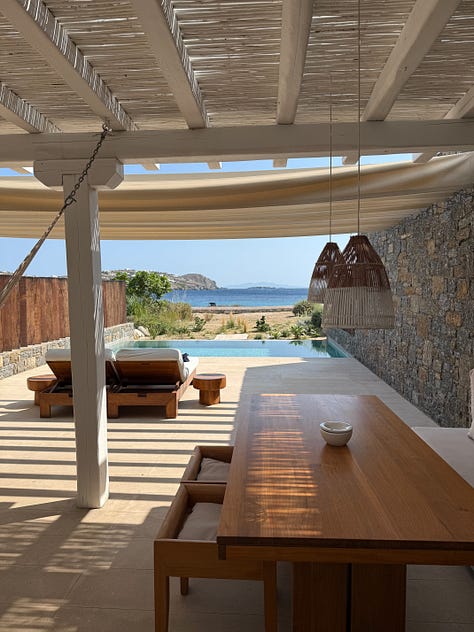

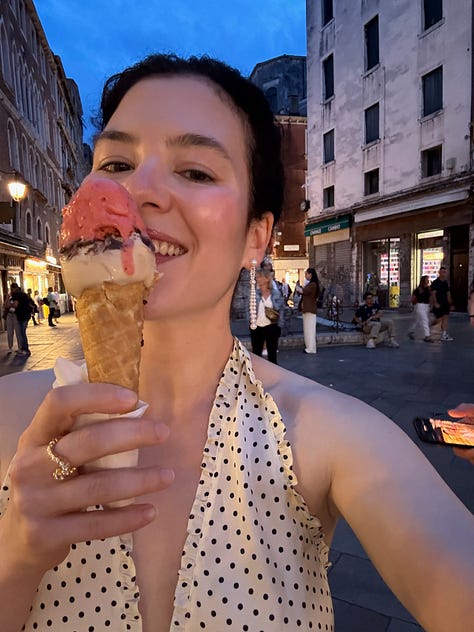
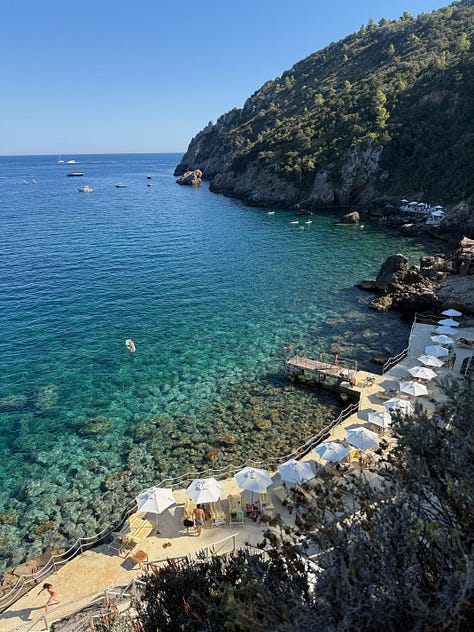
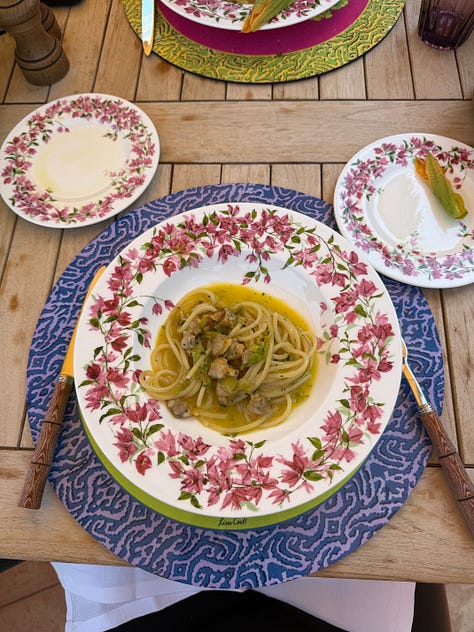
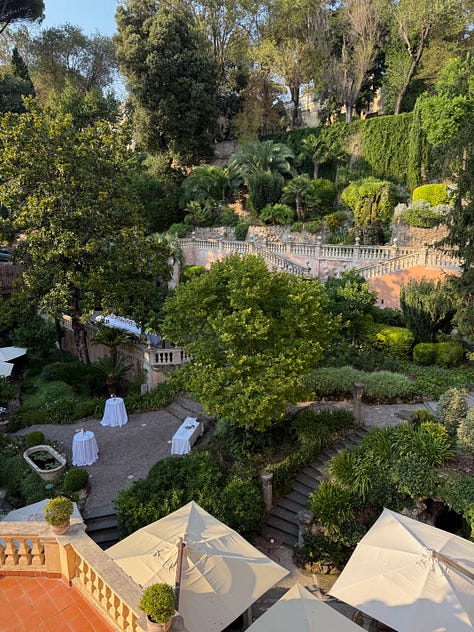
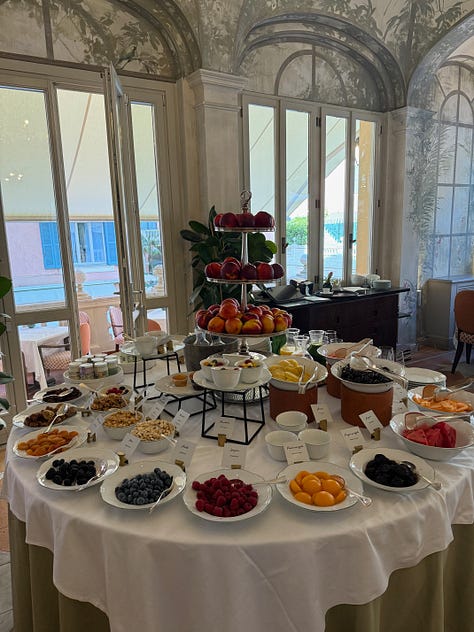

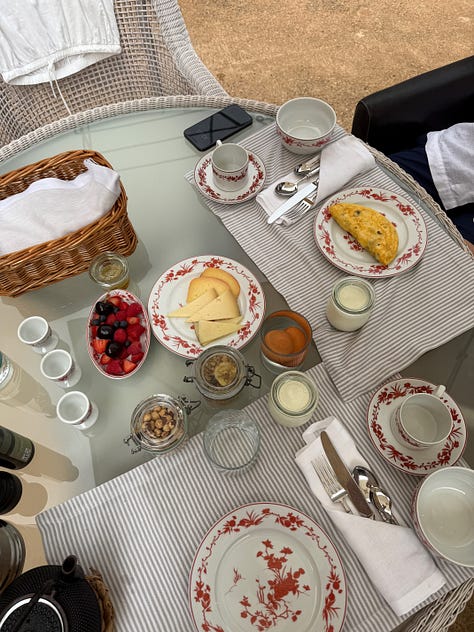
From top left: Bill&Coo coast room, a perfect lunch at Il Pellicano, gelato in Venice, the breathtaking beach view at Pelli, one of many vongole consumed, the magical garden at De Russie in Rome, breakfast at De Russie, the Cap Rocat beach and Cap Rocat breakfast
On food
Oddly enough, food is the easiest part of wellness for me when I travel. I love eating well, and Europe makes it almost effortless: real, fresh, unprocessed food everywhere you go.
Breakfast is my favorite meal, and this summer I had some of the best of my life. At Il Pellicano, De Russie, and Cap Rocat, the spreads were extraordinary: bowls of fresh fruit, vegetables, eggs, local yogurt and cheeses, raw nuts, honey, olive oil, bread, and regional specialties. Even in hotels without such abundance, I’ll keep it simple—boiled eggs, yogurt, berries, sometimes supplemented with a scoop of protein powder I pack with me. A quick aside on the eggs: in good hotels you don’t have to think twice, but elsewhere scrambled eggs are often made from a mix rather than fresh, and usually cooked in butter or low-quality oils I prefer to avoid.
Lunches and dinners in Italy, Spain, and Greece were equally straightforward: fresh fish, plenty of vegetables drenched in olive oil, good bread. And of course, pasta vongole, tiramisu, and gelato. The food quality in Europe is undeniably superior to the U.S., but the difference is not just in what’s on the plate. It’s also in how people eat.
First, portion size. Europeans eat everything—bread, cheese, meat, dessert, wine—but in reasonable amounts. Plates aren’t overloaded, and it’s common to leave a few bites behind.
Second, the mindset. In Europe, there’s an ease around food, a joy that extends into daily life. Meals linger, often with family. People read books by the beach. Pleasure isn’t treated as a luxury or an indulgence, but as an ordinary, sacred, part of living.
One morning at Il Pellicano I noticed two families that captured this difference. At one table, a French family eating eggs, bread, cheese, fruit, sipping coffee, discussing a book one of the children was reading. They were relaxed, almost languid—and slim by every standard. At another table, an American family, louder, larger, more anxious. The mother asked about gluten- and dairy-free options and filled the table with sad substitutes: soy milk, cornflakes, gluten-free muffins. The contrast spoke volumes.
While America has a food quality problem, the deeper issue is cultural: stress, and a fear-driven health narrative. Stress has become part of the American DNA—life here is harder, yes, but also because being busy and burned out is glorified. And then there’s the fear-mongering, the backbone of the wellness industry. Sugar is evil, dairy is evil, gluten is evil, our homes are toxic, our air is toxic, our land is toxic. We are told we’re all afflicted: some of these conditions are real—autoimmunity, for example, is a genuine and growing problem. But many others are dubious at best: mold toxicity, parasites, and my favorite, the ever-expanding catchall of “generational trauma.”
This is why I find myself increasingly misaligned with the wellness industry. The answer is not endless protocols, supplements, and a constant search for new labels to explain our suffering. More often, the answer is subtraction: less stress, fewer rules, and more time. Time to swim in the sea, to eat real bread and cheese, to sit at the table with people you love.
This post ended up longer than Substack thinks anyone should read in one sitting, so I’ll share the rest later this week: what I packed for five weeks, what I saw and read, and what I watched at 35,000 feet.



Loved this!
🩵🌞